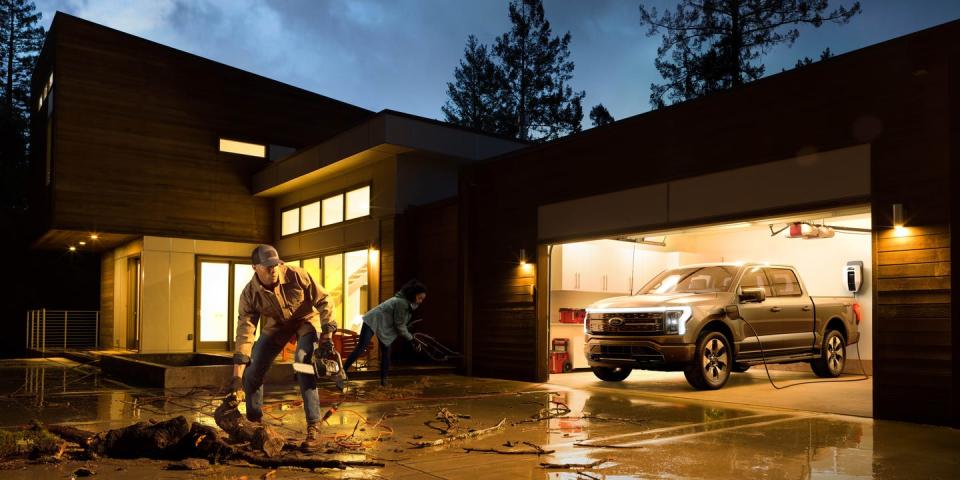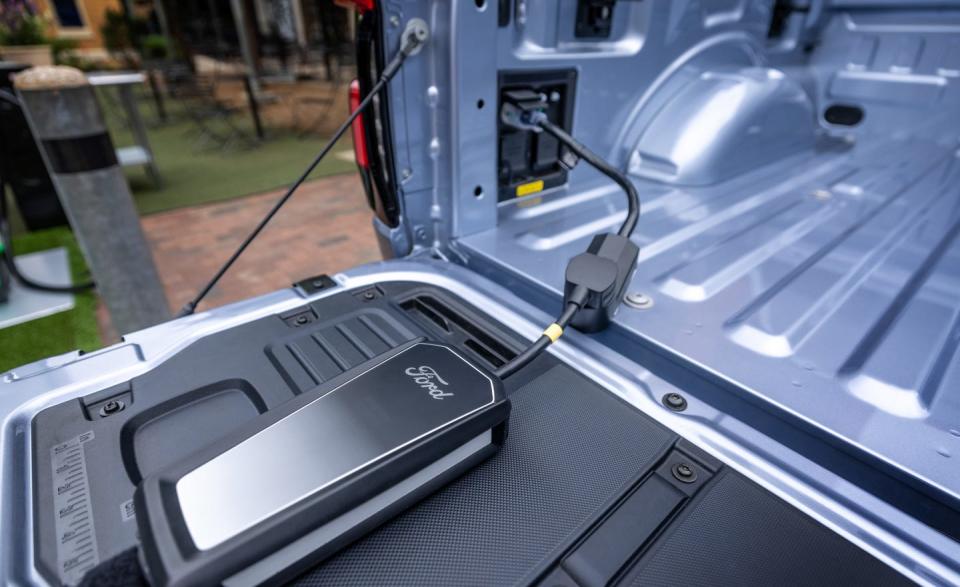Can Your EV Power Your House?

From the April 2022 issue of Car and Driver.
UPDATE 5/11/22: We have updated this story with more details, including pricing for the F-150 Lightning's Charge Station Pro and Home Integration System options.
As the world transitions from large power plants that supply electricity on demand to a more distributed grid, employing solar and wind systems that produce power when they feel like it, the likelihood and duration of power outages is bound to increase. The traditional home solution is to purchase a portable or permanently installed generator to provide backup power.
But electric cars and trucks present another opportunity for backup power. EVs all have batteries large enough to theoretically power a home for several days. The trick is transferring the electrical energy from an EV into useful home AC power.
A number of cars—including the Nissan Leaf and VW EVs from 2022 forward—could theoretically do this, because they have what’s called bi-directional charging, meaning that power can flow both in and out of their batteries. But thus far, only Ford has announced the requisite components to make bi-directional charging work in a house. The system is called Intelligent Backup Power and it’s available in conjunction with the F-150 Lightning.
To appreciate how much electrical power the Lightning can provide, consider that even the standard-range version has a usable battery capacity of 98.0 kilowatt-hours, more than seven Tesla Powerwalls—a well-regarded home battery, The Powerwalls cost $10,500 each, while a base Lightning costs only $41,769—43% less than seven Tesla batteries—plus you get a truck for free. And the extended-range battery holds about 30 percent more electrical energy. The Lightning can pump as much as 9.6 kilowatts into your home, which is enough to power everything you’ll need during a power failure, except possibly your air conditioning system. After all, the typical house uses about 1.3 kW on average, while modern, low energy homes use quite a bit less.

Of course, it’s not quite as simply as plugging a Lightning into your home charger and flipping a switch. First, you need the 19.2 kW Ford Charge Station Pro, which comes standard on extended-range models, but costs $1310 on its own.
You also need the Home Integration System. This is a sophisticated piece of power electronics that takes the high-current DC from the Charge Station Pro and converts into AC power usable in the house. It connects between your home’s utility power meter and your main power panel and disconnects your house power from grid power whenever you need this backup. It costs $3895.
Finally, you will need to pay an electrician to install these two pieces of electrical hardware, as well as the 80-amp wiring and some control wiring between them. That 80-amp wiring is the equivalent of two electric dryer circuits and isn’t strictly necessary unless you also want to harness the full 19.2 kW charging capacity of the Charge Station Pro. But it’s a thick cable that won’t be easy to run, particularly if your garage and basement and power panel location have finished walls. Depending on the size of your power panel, it might also need upsizing to accommodate this additional electrical load.
Predicting this installation cost is impossible because it depends so much on your garage and house layout, but it’s hard to see how even the easiest and simplest installation would cost less than a grand. In my house, which is only two years old, but has a long run through finished walls between the garage charging location and power panel, my electrician gave me a ballpark estimate of five grand.
Ford has partnered with Sunrun, a major nationwide solar system installer to ease this installation process. Sunrun can add a solar cell array to the system to provide free solar electricity and stretch how long the system can power your house while maintaining the charge in your Lightning’s battery. There are some major cost benefits to doing this, as the Home Integration System can serve as the inverter that converts DC power from the solar cells to AC power for the home, eliminating the need for that expensive component in a conventional solar installation. Sunrun will also offer various financing options to reduce the upfront cost of the installation.
The actual cost of installing the Ford hardware isn’t that different than installing a permanent 10-kW backup generator. Depending on how much electricity you use, even the Lightning’s standard-range battery could power your house for a long time. Ford says three days on average, but it would run my low-energy house for five and half days. And it’s dead quiet, unlike most cheap portable generators will wake the dead. Just remember that if you take your truck on an errand, your backup power will go with it.
You Might Also Like

 Yahoo Autos
Yahoo Autos 
